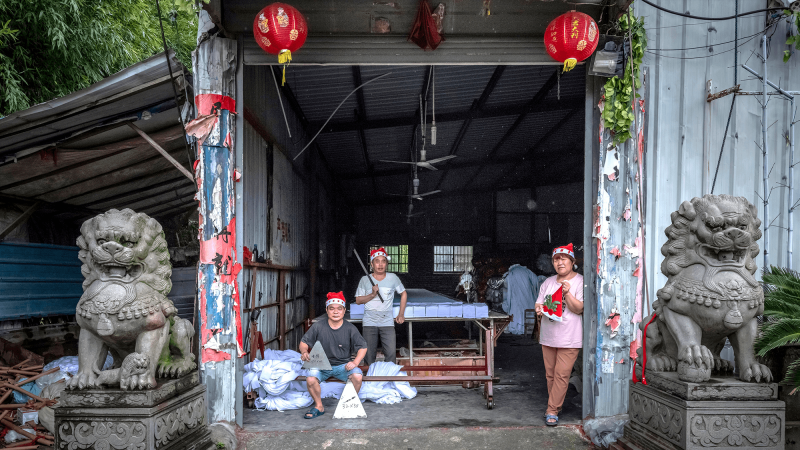In the 2020 Scholastic Art & Writing Awards, the Alliance for Young Artists & Writers recognized 16 high school seniors from across the country with the program’s highest national honor, the Gold Medal Portfolio, which includes a $10,000 scholarship. Throughout the month of May, we are highlighting and interviewing two pairs of Gold Medal Portfolio recipients a week prior to their virtual national ceremony in June. In this Q&A, each pair of recipients were asked a few questions about their nationally recognized portfolios, craft, and future plans. And, to make it more interesting, each Gold Medal Portfolio recipient has also asked each other a question to get to know their fellow medalist.
In today’s installment we get to meet Jerry Sheng from Lakeville, CT, and Isabella “Izzy” Cho from Winnetka, IL.
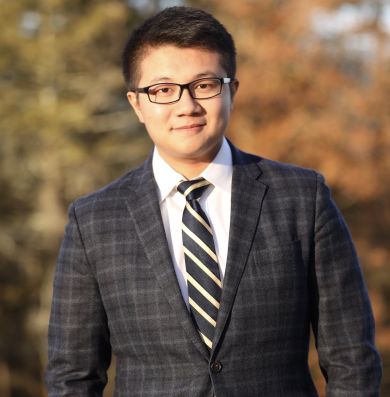
Meet Gold Medal Portfolio recipient Jerry Sheng! Jerry’s nationally recognized portfolio, “Santa’s Real Helpers,” is a series of photographs that documents factory workers in Yiwu, China producing American Christmas decorations. His photographs are meant to awaken viewers and show them the under-explored reality behind commercialized holiday staples.
When did you first know you were a photographer?
I started taking photography back in elementary school, when I was in sixth grade. At that time, I didn’t even have my own camera and instead used my father’s camera to take some photos when we were travelling. Although I never had the chance to take photography classes before entering Hotchkiss, I read many photography books, including the work of Stephen Shore, Robert Frank, and many Chinese photographers.
What was the inspiration behind your portfolio?
Located about 60 miles south of my hometown Hangzhou is a very unique town called Yiwu, which the World Bank labeled as “the world's largest small commodities market”. In 2018, the market sold 1.8 million kinds of goods, worth over $37.5 billion, to 219 countries and regions around the world. The subjects of my portfolio are the Christmas factory workers there.
My original intention of shooting this portfolio is to let the Americans see how the Christmas decorations they enjoy are produced. Through photography, I want to inspire viewers to think about those under-explored worlds that exist in our society.
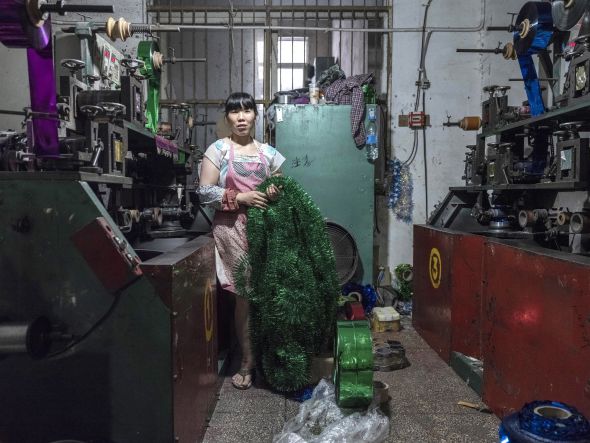
What do you want someone to take away from looking at the pieces in your portfolio?
I hope that people who view my portfolio have a better understanding about where and how many Christmas items are produced, as well as the stories of the workers behind them. Additionally, I wish that viewers can think about the relatively unknown worlds and stories that always exist in our society.
What’s next for you? Will you continue to take photos in your future?
I will attend a four-year undergraduate program in the U.S. this fall (hopefully the colleges can reopen by then!). Winning this award is really a huge encouragement of my photography work and ideas, and I will definitely continue taking photos in the future, as I always do!
If you could have dinner with one notable/famous artist/photographer (living or dead) who would it be and what would you want to talk about with them?
If possible I would love to have dinner with Robert Frank, a renowned photographer from Switzerland who sadly passed away last year. His work, The Americans, is very famous because it captured the nuances of Americans’ daily life. As a Chinese student who studies in the United States, I am interested in learning more about the ideas/original intentions of his work, since he also observed the U.S. from a foreigner’s point of view.
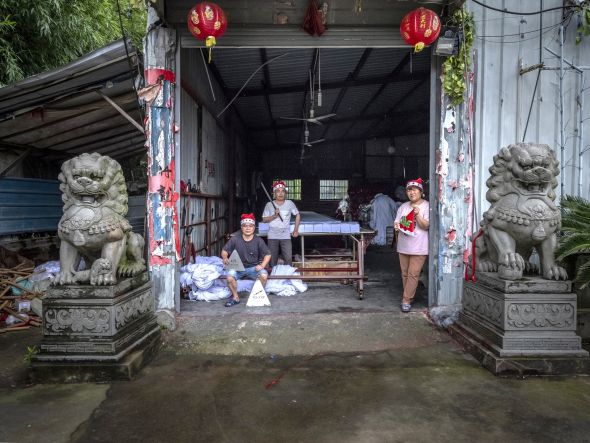
Question from Gold Medal Portfolio recipient Isabella Cho: How do history, mythology, and cultural identity interact or intersect—if at all—in your artwork?
My intention of making this photo portfolio is to document the working conditions in factories, as well as show the cultural comparison between China and the western world. Most of the workers who work in these factories come from poor villages across the country, and don’t have a high education level. For them, Christmas is analogous to the Chinese Spring Festival, but they have no idea about the history and traditions along with it. There is not much mythology playing in this portfolio.
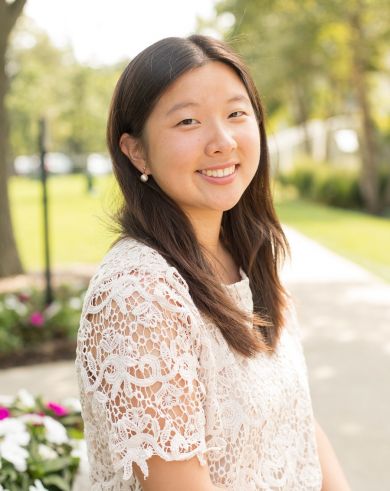
Meet Gold Medal Portfolio recipient Isabella “Izzy” Cho! In her nationally recognized writing portfolio, “On The Night Train Headed to Mars,” Isabella explores dynamic questions of loss, disorientation, cultural duality, bilingualism, ethnic otherness, and technology, which encourages readers to ask how these topics inform the ways in which people navigate communities and the world at large.
When did you first know you were a writer?
I’m not sure that for anyone there’s a moment when they think, “Yes, I’m a writer now.” I think the ambiguity of that term “writer” reflects both the thrill and perpetual challenge of writing — there is no tangible way to gauge writing, no formal way to “become” a writer. I began exploring creative writing at a young age. After a while, I found myself gravitating toward the craft whenever I felt startled by the intensity of my emotions, confused by a seminal event in my life, or moved by the redemptive beauty of ordinary moments. Perhaps it was then, when I started trusting the written word as a vehicle for introspection and interrogation, that I truly started appreciating my identity as a writer.
What was the inspiration behind your portfolio?
For me, the entire notion of inspiration is difficult to pin down. Rather than manifest in localized, clean-cut moments, I think that a lot of the inspiration for my portfolio just came from living, and interacting with family, friends, and people in my communities. I think that I tend to subliminally process moments or events or interactions—they sort of simmer in my mind for a bit, and then, all of a sudden, I’ll remember something, or see a lived experience in a new light. That’s when I try to put that insight onto paper through a poem or another creative work. At large, though, my family, as well as my parents’ homeland of South Korea, was seminal to my creative process. Taking in South Korea’s rural and urban landscapes, having conversations with my grandparents about their experiences during the Korean War, and just viscerally experiencing how everything was so different from my home in the suburbs of Chicago were challenging, yet gratifying exercises in introspection. I think that my work also deals a lot with distance—distance in a geographical, emotional, and psychological sense. Many of the works in my portfolio emerged from a desire to more clearly discern how distance— whether that be in the context of a relationship, a homeland, an idea—informs the ways in which we relate to other people and ourselves.
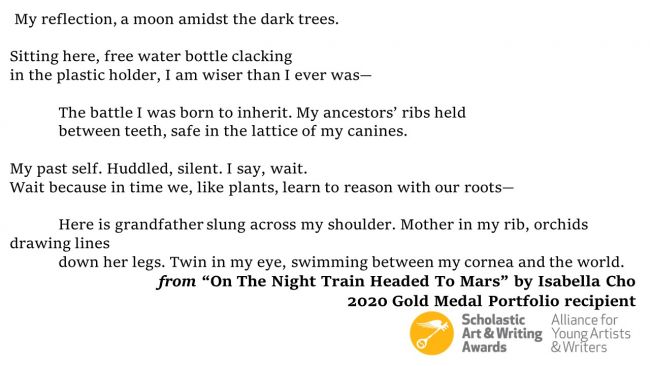
What do you want someone to take away from reading the pieces in your portfolio?
I’m not sure whether there’s a singular idea that I’d like readers to take away from my portfolio. I’ve translated my own lived experiences, my own revelations, onto the page. Once I’ve written down my ideas, it’s up to the reader to absorb and appreciate what they will from the text — I think that’s what makes the entire process of creative writing and of sharing that writing so vulnerable. That being said, if there’s something that I’d like readers to take away from my pieces, I think it would be the idea that we, by virtue of being in vivid possession of our stories, have the capacity to govern the ways in which we frame and perceive the world, the ways in which we present ourselves to others. Though we may feel powerless in certain situations or in certain mechanisms of systemic injustice or repression, there is a sense of dignity, of feeling grounded, in the awareness that our stories are ours to breathe life into.
What’s next for you? Will you continue to write in the future?
In terms of school, I recently committed to Harvard College’s class of 2024. I’m super grateful for the opportunity to live and study alongside a group of driven, passionate, wide-ranging peers, and I’m hoping to use that opportunity to do a lot of self-reflecting and achieve a more definitive idea of what I’d like to do for the rest of my life. Though I’m unsure of whether I want to pursue writing in a professional capacity, I think I’ll always write in some way or another. Writing creatively has been more than a “hobby” for me — it’s a medium through which I’m able to foster an involved internal dialogue, to interrogate the deepest questions and reservations about myself and the world I inhabit. I’ll always turn back to the page when seeking moments of solace, inquiry, beauty, or hope.
If you could have dinner with one notable/famous writer (living or dead) who would it be and what would you want to talk about with them?
Seamus Heaney. In particular, there’s a poem of his we discussed this year in English class. It’s called “When all the others were away at Mass.” What I love so much about the poem, and about Heaney’s body of poetic work at large, is his ability to confer a sense of enduring dignity to the most ordinary moments of our lives. For instance, in “When all the others,” Heaney describes the simple act of cutting potatoes as not merely a menial task but, rather, as a gesture of quietly profound intimacy and love. If I were to speak with him, I’d love to dialogue about how his attentiveness to — or perhaps even reverence of — the ordinary has shaped his writing.
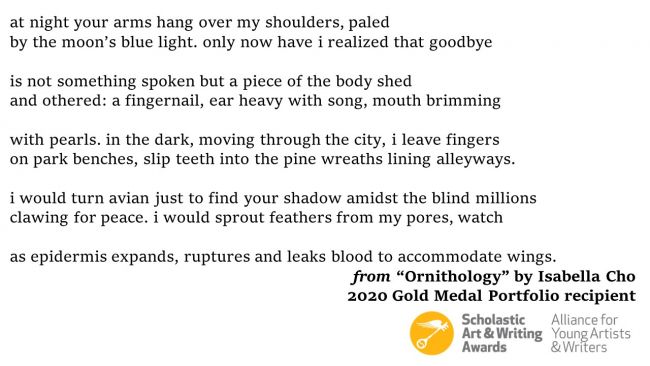
Question from Gold Medal Portfolio recipient Jerry Sheng: What is your opinion on the current relationships between human-beings and birds, has it improved? I feel that a great theme of this poem is about missing someone. How’s the global pandemic situation influencing your sense and perspective, if any?
Honestly, I don't know too much about the scientific, literal relationship between humans and birds. In my poem, I intend to explore the symbolism of birds. In literature, avian imagery often suggests flight and, by extension, liberation, and I wanted to examine those thematic undercurrents in my work through evoking those creatures. As you mentioned, a primary focus of "ornithology" is the nature of human longing and relationships, and living through COVID-19 has definitely helped me more cogently articulate those abstract concepts. The pandemic has challenged me to reappraise my sense of distance and priority. Often, when I'm in the midst of school, I get swept up in the current of everyday tasks; it becomes difficult to take in the big picture. During quarantine, I've had a lot of opportunities for introspection, and I'm starting to more clearly see what I value most in life—my health, my family, our collective happiness. Perhaps most importantly, reading the news and following the escalation of economic hardship and xenophobia during the pandemic has encouraged me to reflect on my own privilege. It has challenged me to cultivate gratitude and put my own struggles into perspective. I think that COVID in general has been a collective exercise in humility, in coming to terms with our vulnerability as people, no matter how invincible we may think ourselves to be. Witnessing second-hand the hardship that so many individuals are experiencing, as well as reflecting on glimpsed moments of decency and solidarity, has definitely served as both personal and literary inspiration.
Stay tuned for early next week when we get to know another pair of Gold Medal Portfolio recipients!
If you’re interested in learning more about past and present Gold Medal Portfolio winners visit the Eyes on the Prize series on the Alliance for Young Artists & Writers blog.
Cover photo: JERRY SHENG, Santa's Real Helpers, Photograph; Photos in body: JERRY SHENG, Headshot, Photograph; JERRY SHENG, In The Workshop, Photograph; JERRY SHENG, Santa's Real Helpers, Photograph; ISABELLA CHO, Headshot, Photograph; ISABELLA CHO,'On The Night Train Headed To Mars,' Writing; ISABELLA CHO, 'Ornithology,' Writing.

